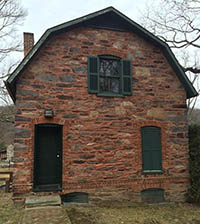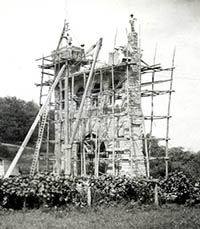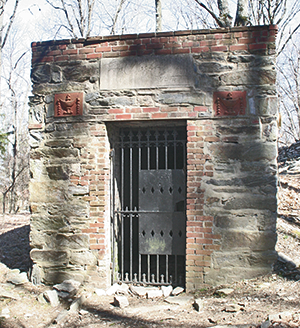George Alfred Townsend and Gathland State Park
Gathland State Park encompasses many layers of history. The park was the scene of significant action during the Battle of South Mountain. Following the Civil War, George Alfred Townsend established an estate here. His pen name, GATH, was used in naming the state park – Gathland.
 Life/Career
Life/Career
George Alfred Townsend was born January 30, 1841 in Georgetown, Delaware. Townsend’s father, a Methodist minister, traveled to several parishes’ to support his large, poor family. In contrast, Gath lived a life of relative luxury with his wife, Bessie Rhodes (1842-1903) and two children Genevieve (1866-1942) and George Alfred Townsend, Jr. (1874-unknown). By the young age of 21, Gath would begin his literary career as a Civil War Correspondent and later a published journalist and author.
Townsend began his career in 1862 as a Civil War correspondent for the New York Herald newspaper. Townsend followed the Army of the Potomac during the Peninsula Campaign, reporting on several well-known battles at the time. Townsend continued south with the Union Army to the Chickahominy River swamps, where he became ill with what was known as “Chickahominy Fever.” Shortly after, he left the Herald and traveled overseas to Europe to recover his health. While in Europe, Townsend gave lectures on the American Civil War to the English and other Europeans. Townsend lived overseas for roughly two years, before he returned to the states in the middle of 1864.
By 1865, Townsend returned to reporting on the war, this time as a reporter for the New York World. By this point of the war, all correspondents were required to sign their names to their works. Townsend devised a new penname for himself, GATH, using his initials “G.A.T” and adding a “H.”
In April of 1865, Gath would report on the story that would make him a household name in America. On April 15, President Abraham Lincoln was assassinated at Ford’s Theater by the stage actor and Confederate sympathizer, John Wilkes Booth. As Booth and his co-conspirators attempted to escape capture, Gath rushed to Washington to report on this national news. From April 17 until May 17, Gath reported on Booth’s capture and death and the capture and executions of his co-conspirators. Using his political connections, Townsend was able to interview high-level military and government personnel, police detectives and eye witnesses. He attended the co-conspirators’ trials, heard their verdicts and watched their executions by hanging.
Overall, Gath wrote nine “Letters” to the New York World, describing and analyzing the events that followed President Lincoln’s death. Shortly after, Gath’s “Letters” were bound together and published as The Life, Crime and Capture of John Wilkes Booth (1865). As one of the few first-hand accounts of the Lincoln assassination, Gath’s book is a rare primary source of information used by many Lincoln scholars even today.
Gapland
At the end of the Civil War, Gath used his experience and notoriety to begin a long and dedicated literary career. In 1867, he moved to Washington, D.C., the center point of politics, where he wrote for multiple newspapers as a political correspondent for the next 40 years. Additionally, he wrote poetry, and published plays and several novels.
 For many of his published works, Gath began his projects with extensive research. Most notably, in 1884, he traveled across Western Maryland for his novel, Katy of Catoctin, a book about John Brown, John Wilkes Booth and Civil War America. While visiting the South Mountain region, specifically Crampton’s Gap, he fell in love with the area and purchased 100 acres of the mountainous land. For the next 20 years, Gath designed and built a total of 10 structures on the summer home estate he named Gapland.
For many of his published works, Gath began his projects with extensive research. Most notably, in 1884, he traveled across Western Maryland for his novel, Katy of Catoctin, a book about John Brown, John Wilkes Booth and Civil War America. While visiting the South Mountain region, specifically Crampton’s Gap, he fell in love with the area and purchased 100 acres of the mountainous land. For the next 20 years, Gath designed and built a total of 10 structures on the summer home estate he named Gapland.
 Civil War Correspondents
Civil War Correspondents
War Correspondence as a profession made its “coming of age” during the Civil War. The American public was desperate for any information available about the fighting. Both Northern and Southern newspapers sent reporters, artisans and photographers to the front lines to collect as much information as possible. Citizens and soldiers alike would wait daily for newspaper reports to stay up-to-date on the war.
Over 500 reporters traveled along side the armies, sending telegrams of first-hand accounts of vital information, such as troop movements, army victory and losses, and the constantly increasing wounded and death tolls. Newspapers also hired illustrators and photographers to capture stills of the front lines. Craftsmen were hired to engrave these sketches and photographs onto wood blocks as a faster and cheaper option for mass image production. The public’s knowledge of the war was largely thanks to the dedication of the war correspondent.
War Correspondent Memorial Arch
To commemorate the hard-working correspondents who served along side him, Townsend designated a section of his land at Gapland to house a memorial for Civil War Correspondents. He designed, built, and dedicated the 50ft high by 40ft wide War Correspondent Memorial Arch from 1895 to 1896. The arch included statues, quotes, and the names of Northern and Southern Civil War correspondents. Near the end of his life, Townsend had lost most of his wealth primarily from his lost in literary popularity. To pay for the arch, he had to raise most of the funds through his wealthy personal connections. Several notable donors to the arch included Thomas Edison, J.P. Morgan and Joseph Pulitzer, amongst others.
 In 1904, shortly before his death, Gath deeded the arch to the War Department, which later transferred to the National Park Service in 1933. In 1946, the Arch’s 50th anniversary, the memorial was rededicated to include war correspondents of all wars. Today, the National Park Service maintains the arch and the surrounding land as a national monument situated within Maryland’s Gathland State Park.
In 1904, shortly before his death, Gath deeded the arch to the War Department, which later transferred to the National Park Service in 1933. In 1946, the Arch’s 50th anniversary, the memorial was rededicated to include war correspondents of all wars. Today, the National Park Service maintains the arch and the surrounding land as a national monument situated within Maryland’s Gathland State Park.
Park Location
Gathland State Park is located in Washington and Frederick counties, one mile west of Burkittsville, off MD Route 17.
Gathland State Park
c/o Greenbrier State Park
21843 National Pike
Boonsboro, MD 21713-9535
Phone (301) 791-4767